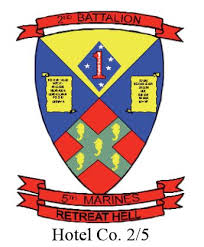SILVER STAR RECIPIENTS
 The Silver Star is the fifth-highest U.S. combat-only award. Established in 1918 as the Citation Star, in 1932 a provision allowed servicemen to receive it retroactively. It has been awarded for valor in combat actions as far back as the Spanish-American War.
The Silver Star is the fifth-highest U.S. combat-only award. Established in 1918 as the Citation Star, in 1932 a provision allowed servicemen to receive it retroactively. It has been awarded for valor in combat actions as far back as the Spanish-American War.
The Silver Star Medal is awarded for singular acts of valor or heroism over a brief period, such as one or two days of a battle. This silver star medal is a personal valor decoration awarded for gallantry in action against an enemy of the United States as presented by the President of the United States.
We honor our Hotel 2/5 recipients:
The Silver Star Award is the United States’ fifth-highest award exclusively for military operations involving conflict and ranks fifth in the precedence of military awards behind the Medal of Honor, the Crosses (Distinguished Service Cross; Navy Cross; and Air Force Cross), the Defense Distinguished Service Medal (awarded by the Department of Defense), and the Distinguished Service Medals of the various branches of service. It is the highest award for combat valor that is not unique to any specific branch; it has been bestowed by the Army, Navy, Marine Corps, Air Force, Coast Guard, and Merchant Marines. It may be given by any one of the individual services to not only their own members, but to members of other branches of service, foreign allies, and even to civilians for “gallantry in action” in support of combat missions of the United States military.
Because the Silver Star is only awarded for combat valor, the only award devices worn on it are:
- Bronze Oak Leaf Clusters in lieu of additional Army/AF awards
- Silver Oak Leaf Clusters in lieu of a sixth Army/AF award
- Gold Star in lieu of additional Navy/USMC awards
- Silver Star in lieu of a sixth Navy/USMC award.
(Seven Awards of the Silver Star then, would be displayed on the ribbon as a Silver OLC and 1 Bronze OLC for Army or Air Force. For Navy/Marine Corps Awards it would be a Silver Star plus 1 Gold Star.)
Established by President Woodrow Wilson
The Silver Star Medal was established by President Woodrow Wilson as the “Citation Star” during World War I, and was awarded solely by the U.S. Army, though it was presented by the War Department to members of the U.S. Navy and Marines. Originally, it provided for a 3/16″ silver star to be worn on the ribbon of the service medal for the campaign in which the citation was given. Based loosely upon the earlier Certificate of Merit, the Citation Star was retroactively available to those who distinguished themselves while engaged in military operations as far back as the Spanish-American War. (Subsequently, it has been awarded for gallantry to Civil War heroes who were similarly cited for gallantry in action.) Prior to 1932, the General Orders announcing awards of the “Citation Star” typically began:
“By direction of the President, under the provisions of the act of Congress approved July 19, 1918 (Bul. No. 43, W.D., 1918), the following-named officers and enlisted men are cited for gallantry in action and a silver star may be placed upon the ribbon of the Victory Medals awarded to such officers and enlisted men.” (A narrative of the act or acts followed for each man thus cited.)
On February 22, 1932, the date that would have been George Washington’s 200th birthday, Army Chief of Staff General Douglas MacArthur revived General Washington’s “Badge for Military Merit (1782)” as the Purple Heart. That same year he also successfully advocated the conversion of the “Citation Star”. When his recommendation was approved by the Secretary of War, the 3/16′ silver star was converted from a ribbon device” to a full-fledged medal.
 Certificate of Merit Medal – Silver Star Predecessor
Certificate of Merit Medal – Silver Star Predecessor
The Silver Star Medal was designed by Rudolf Freund of Bailey, Banks, and Biddle, and consisted of a gilt-bronze five-pointed (point-up in contrast to the point-down design of the Medal of Honor) star bearing a laurel wreath at its center. The ribbon design incorporated the colors of the flag, and closely resembled the medal’s earliest predecessor, the Certificate of Merit Medal. The reverse of the medal is blank, save for the raised text “For Gallantry in Action”, beneath which is usually engraved the name of the recipient.
Is The Silver Star Made of Silver?
Technically, the Silver Star is not made of actual Silver. The gold hue of the gilt-bronze – ormolu – star seems at odds with the award’s name. The name “Silver Star” originated in World War I because of the 3/6″ silver star that is displayed in the center of the medal.
The Silver Star Medal remained exclusively an Army decoration until August 7, 1942, nearly a year after World War II began. On that date, the Silver Star Medal was expanded by an Act of Congress for award by the Navy Department for actions on or after December 7, 1941, (Public Law 702, 77th Congress).
We estimate that the number of Silver Star Medals awarded during World War I and the present day is somewhere between 100,000 and 150,000. While that number seems quite large, when compared to the more than 30 million American men and women who have served in uniform during that time period, it is obvious that the Silver Star is a rare award, bestowed on fewer than 1 in every 250 veterans of military service.

